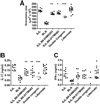Genetic control of severe egg-induced immunopathology and IL-17 production in murine schistosomiasis
- PMID: 19675160
- PMCID: PMC2874957
- DOI: 10.4049/jimmunol.0901504
Genetic control of severe egg-induced immunopathology and IL-17 production in murine schistosomiasis
Abstract
Infection with the trematode parasite Schistosoma mansoni results in a distinct heterogeneity of disease severity, both in humans and in an experimental mouse model. Severe disease is characterized by pronounced hepatic egg-induced granulomatous inflammation in a proinflammatory cytokine environment, whereas mild disease corresponds with reduced hepatic inflammation in a Th2 skewed cytokine environment. This marked heterogeneity indicates that genetic differences play a significant role in disease development, yet little is known about the genetic basis of dissimilar immunopathology. To investigate the role of genetic susceptibility in murine schistosomiasis, quantitative trait loci analysis was performed on F(2) progeny derived from SJL/J and C57BL/6 mice, which develop severe and mild pathology, respectively. In this study, we show that severe liver pathology in F(2) mice 7 wk after infection significantly correlated with an increase in the production of the proinflammatory cytokines IL-17, IFN-gamma, and TNF-alpha by schistosome egg Ag-stimulated mesenteric lymph node cells. Quantitative trait loci analysis identified several genetic intervals controlling immunopathology as well as IL-17 and IFN-gamma production. Egg granuloma size exhibited significant linkage to two loci, D4Mit203 and D17Mit82, both of which were inherited in a BL/6 dominant manner. Furthermore, a significant reduction of hepatic granulomatous inflammation and IL-17 production in interval-specific congenic mice demonstrated that the two identified genetic loci have a decisive effect on the development of immunopathology in murine schistosomiasis.
Figures






Similar articles
-
IL-23 is required for the development of severe egg-induced immunopathology in schistosomiasis and for lesional expression of IL-17.J Immunol. 2008 Feb 15;180(4):2486-95. doi: 10.4049/jimmunol.180.4.2486. J Immunol. 2008. PMID: 18250458
-
Coinfection with the intestinal nematode Heligmosomoides polygyrus markedly reduces hepatic egg-induced immunopathology and proinflammatory cytokines in mouse models of severe schistosomiasis.Infect Immun. 2008 Nov;76(11):5164-72. doi: 10.1128/IAI.00673-08. Epub 2008 Aug 18. Infect Immun. 2008. PMID: 18710859 Free PMC article.
-
Schistosome-infected IL-4 receptor knockout (KO) mice, in contrast to IL-4 KO mice, fail to develop granulomatous pathology while maintaining the same lymphokine expression profile.J Immunol. 1999 Jul 1;163(1):337-42. J Immunol. 1999. PMID: 10384133
-
The role of cytokines in the formation of the schistosome egg granuloma.Immunobiology. 1994 Oct;191(4-5):441-50. doi: 10.1016/S0171-2985(11)80450-X. Immunobiology. 1994. PMID: 7713558 Review.
-
Experimental models of Schistosoma mansoni infection.Mem Inst Oswaldo Cruz. 2002 Oct;97(7):917-40. doi: 10.1590/s0074-02762002000700002. Mem Inst Oswaldo Cruz. 2002. PMID: 12471417 Review.
Cited by
-
Expression of TLR2, TLR3, TLR4, and TLR7 on pulmonary lymphocytes of Schistosoma japonicum-infected C57BL/6 mice.Innate Immun. 2019 May;25(4):224-234. doi: 10.1177/1753425919840424. Innate Immun. 2019. PMID: 31018808 Free PMC article.
-
IRAK-2 regulates IL-1-mediated pathogenic Th17 cell development in helminthic infection.PLoS Pathog. 2011 Oct;7(10):e1002272. doi: 10.1371/journal.ppat.1002272. Epub 2011 Oct 6. PLoS Pathog. 2011. PMID: 21998578 Free PMC article.
-
Schistosoma mansoni experimental infection in Mus spretus (SPRET/EiJ strain) mice.Parasite. 2013;20:27. doi: 10.1051/parasite/2013027. Epub 2013 Aug 29. Parasite. 2013. PMID: 23985166 Free PMC article.
-
Dynamics of Th17 cells and their role in Schistosoma japonicum infection in C57BL/6 mice.PLoS Negl Trop Dis. 2011 Nov;5(11):e1399. doi: 10.1371/journal.pntd.0001399. Epub 2011 Nov 15. PLoS Negl Trop Dis. 2011. PMID: 22102924 Free PMC article.
-
A non-synonymous polymorphism in IL-23R Gene (rs1884444) is associated with reduced risk to schistosomiasis-associated Immune Reconstitution Inflammatory Syndrome in a Kenyan population.BMC Infect Dis. 2014 Jun 10;14:316. doi: 10.1186/1471-2334-14-316. BMC Infect Dis. 2014. PMID: 24912586 Free PMC article.
References
-
- Pennacchio LA. Insights from human/mouse genome comparisons. Mamm. Genome. 2003;14:429–436. - PubMed
-
- Peters LL, Robledo RF, Bult CJ, Churchill GA, Paigen BJ, Svenson KL. The mouse as a model for human biology: a resource guide for complex trait analysis. Nat. Rev. Genet. 2007;8:58–69. - PubMed
-
- Sugiyama F, Churchill GA, Higgins DC, Johns C, Makaritsis KP, Gavras H, Paigen B. Concordance of murine quantitative trait loci for salt-induced hypertension with rat and human loci. Genomics. 2001;71:70–77. - PubMed
-
- Hillebrandt S, Wasmuth HE, Weiskirchen R, Hellerbrand C, Keppeler H, Werth A, Schirin-Sokhan R, Wilkens G, Geier A, Lorenzen J, et al. Complement factor 5 is a quantitative trait gene that modifies liver fibrogenesis in mice and humans. Nat. Genet. 2005;37:835–843. - PubMed
-
- Ueda H, Howson JM, Esposito L, Heward J, Snook H, Chamberlain G, Rainbow DB, Hunter KM, Smith AN, Di Genova G, et al. Association of the T-cell regulatory gene CTLA4 with susceptibility to autoimmune disease. Nature. 2003;423:506–511. - PubMed
Publication types
MeSH terms
Substances
Grants and funding
LinkOut - more resources
Full Text Sources
Molecular Biology Databases
Miscellaneous

